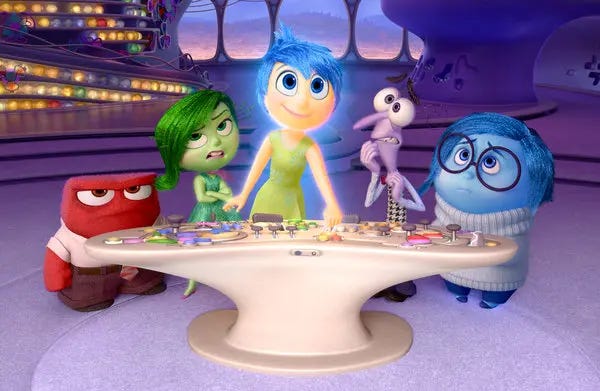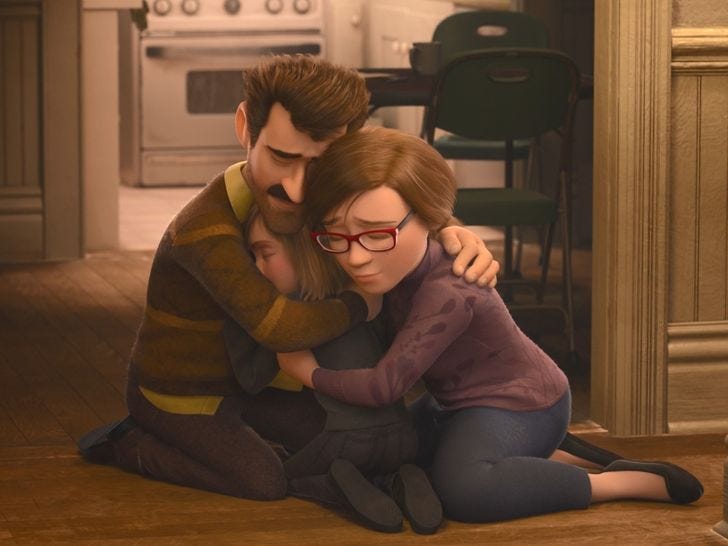The role of grief in depression and mania: What Inside Out teaches us
An analysis of the 2015 animated film through a psychoanalytic perspective
Something I love about the Pixar animated film Inside Out (which, as I just found out through websearch, has a sequel planned for release next June) is that it makes a clear distinction between sadness and depression. For those unfamiliar with the film (and those who watched it long ago and need a refresher), I will summarize the plot. The movie is about an 11-year-old girl named Riley whose family has just moved from Minnesota to San Francisco. The narrative is told from the perspective of the five emotions in Riley’s brain: Joy, Sadness, Anger, Fear, and Disgust. (I’m not sure why the makers of the film did not include Surprise, the last of the widely-recognized six basic emotions.) Joy is the leader of the emotions, having the role of keeping Riley happy. She recognizes the roles of Anger, Fear, and Disgust to protecting Riley’s wellbeing, but she has no idea what purpose Sadness has, so she seeks to limit Sadness’s influence in the Headquarters of Riley’s mind.

Sadness herself is confused about her role, yet as Riley tries to adjust to her new life in San Francisco, Sadness starts feeling compelled to turn once-joyful memories from Riley’s old life in Minnesota into sad memories. Joy desperately tries to get rid of the sad memories, but this causes Joy and Sadness to get sucked out of Headquarters and into the deeper parts of Riley’s psyche.
Without Joy to keep everyone organized, Anger, Fear, and Disgust jostle for control in Headquarters. Their chaos causes Riley to repeatedly act out, crumbling the foundations of Riley’s personality (represented in the film by personality “islands” visible from Headquarters): her relationships with family and friends, her interests in hockey and fun, and her honesty. Eventually, Anger decides to cause Riley to run away to Minnesota, believing that only by returning to the past can she be happy again.
What happens next provides us with the key psychological insights of this deeply philosophical film. While Anger, Fear, and Disgust were causing chaos, Joy and Sadness were journeying through Riley’s subconscious, trying to find their way back to Headquarters. By the time they return, Riley has boarded a bus back to Minnesota. All her personality islands have crumbled, and the dashboard that the emotions use to control Riley’s actions has become inoperable, showing us that Riley has shut down into depression. Joy, having discovered while en route to Headquarters a core memory that turned from sad to joyful, is now beginning to understand Sadness’s role in the team of emotions: Sadness motivates Riley to seek support so that she may feel joy again.
Empowered with this realization, Joy invites Sadness to take charge of the dashboard, which miraculously reawakens with Sadness’s touch. Riley begins to cry, finally able to feel the sadness that has been underlying her angst. She tells the bus driver to let her off the bus, and she returns home to her family. Once she gets home, Riley and her parents embrace each other. Right at this moment, Joy and Sadness team up at the dashboard to create, for the first time, a mixed-emotion memory: a bittersweet moment of joy and sadness combined.

Notice that Riley’s depressive state happens when neither Joy nor Sadness was present in Headquarters. Depression is often associated with sadness, but it is not simply a state of extreme sadness. Rather, in Riley’s case, it is an inability to feel anything at all. Unable to connect with the core parts of herself (her personality islands), and unable to grieve what she has lost upon moving to San Francisco, Riley shuts down and becomes trapped in the past, riding a bus back to Minnesota under the delusion that she could make the past become present again. It is only when Riley is able to feel her sadness, to acknowledge that something important to her has truly been irretrievably lost, that she awakens from her brief depression and is ready, with the support of her loving parents, to rebuild her personality islands in the context of a new life. As Sigmund Freud wrote, grief is when what is perceived to be lost is external to oneself (Riley’s old life in Minnesota), while depression is when what is perceived to be lost is part of self (Riley’s personality islands).
The character of Joy in Inside Out can be considered as having a hypomanic personality. Hypomanic personality disorder, or alternatively cyclothymic personality disorder, is a diagnosis that existed in the second edition of the Diagnostic and Statistical Manual of Mental Disorders (DSM-II, published in 1968) but was removed, along with depressive personality disorder, upon publication of the DSM-III due to all mood-related phenomena becoming categorized under “mood disorders.” Yet the concept of a hypomanic personality has seen a resurgence in recent years among some in the psych fields, due to the existence of clients who consistently present with traits usually associated with mania and/or hypomania but who do not necessarily meet the criteria for bipolar disorder. People with hypomanic personalities are constantly cheerful, energetic, optimistic, and social, sometimes to the point of exhausting those around them. For those of us who have more of a depressive or “downer” personality organization, this abundant cheerfulness may seem a wonderful gift, yet according to psychoanalytic theory, underlying this bubbly positivity is a denial of the negative:
The core defenses of manic and hypomanic people are denial and acting out. Denial is conspicuous in their tendency to ignore (or to transform into humor) events that would distress or alarm others. Acting out often takes the form of flight: They run from situations that might threaten them with loss….For a manic person, anything that distracts is preferable to emotional suffering.
Nancy McWilliams, Psychoanalytic Diagnosis, second edition (p. 258)
At the start of the film, Joy denies that Sadness could possibly have a purpose in Riley’s life. Joy loves everything positive and hates to be a downer, even while Riley is navigating a big change in her life and must process the loss of her old life in Minnesota. Joy’s attempts to keep Sadness from influencing anything in Riley’s mind only cause both her and Sadness to be sucked out of Headquarters, eventually leading Riley to become depressed. The denial of grief cannot last forever: people who experience mania or hypomania frequently cycle into depressive episodes right after, and even people with consistently hypomanic personalities, whose highs are more of a mild simmer, are often prone to occasional bouts of depression.
When Joy and Sadness team up to create the mixed-emotion memory, they not only balance each other’s powers, but also embrace a fuller experience of reality. There is not only sadness in Riley’s move from Minnesota, and there is not only joy in her starting anew in San Francisco. By holding together her complex feelings towards past and future, Riley is now more capable of grounding herself in the present and making the decisions that will help her grow as Riley.
From a psychoanalytic perspective, depression is an inability to grieve (or, in some cases, to grieve through), while mania is a denial of grief. Not everyone’s depressive or manic episodes may necessarily align with these explanations, however; people’s psyches function in so many diverse ways still mysterious to science, and different theories and frameworks resonate with some people more than others. I personally love psychoanalysis and find that it elucidates my own struggles and psychological patterns and has aided in my healing. Some people may find psychoanalysis unhelpful and prefer cognitive-behavioral, biomedical, or non-Western frameworks instead. Due to popular misconceptions that psychoanalysis is outdated and unsupported by empirical evidence (see this article published by the American Psychological Association for a discussion of research on modern psychoanalysis), I suspect that there are many more people who would benefit from psychoanalytic frameworks (and there are multiple) than are currently acquainted. Thus I share the knowledge I have gathered from my passionate reading, in hopes that some may benefit.
As a person diagnosed with bipolar disorder who also observes a hypomanic dynamic in their personality, I have been thinking of how I can relate better to my grief. Some of my struggles in the past arose from my being so enthusiastic about change and forward motion that I forgot to acknowledge the grief and anxiety I also feel about change. I went onward and onward until I lost steam and the tides of grief came washing over, disorienting me and trapping me in my past.
I also think of how other members of my family relate to grief, for although no one else has experienced bipolar episodes, I don’t think anyone really has a healthy relationship to grief. Notably, my mother is somewhat death-phobic: when I was a child, she refused to let us have a pet that was not a fish because it would be too painful when the pet died, and she would not allow me to buy clothes at thrift stores because she didn’t want me to wear what was potentially a dead person’s clothing. When her father died early in the pandemic due to reasons unrelated to the pandemic, my father had the audacity to tell my mother and me to “get over it” only a few minutes after we learned the news. We never processed our grief as a family or performed any sort of ritual regarding this, even though this Chinese grandparent of mine had visited us in the U.S. two or three times during my childhood and was thus a person I somewhat knew. So I have not had very good models of how to grieve in my life. But that does not mean I cannot learn.
What are you grieving today? It may not be something major or a commonly acknowledged object of grief, and the loss may have occurred recently or long ago, over a brief or extended period of time. Sometimes we grieve what we never had: a stable family, a nourishing childhood, a life free from capitalism, oppression, and ecological destruction. I think of the Swarthmore College student I met in my first year of college who, on the day of a global climate strike, sat in front of the administrative building on campus with a sign inviting others to come and grieve. We speak so much of hope during times of darkness and crisis: what if we also reached down into the aquifers of grief, nourished and cleansed ourselves with truth-feeling tears? So much is lost already, and we must learn to live with loss. Otherwise, we become delusional, increasingly out-of-touch with our fellow beings and ourselves.
Did this essay make you think, feel, question, object? Converse with me in the comments below. And please share this newsletter with likehearted thinkers, creators, dreamers!




